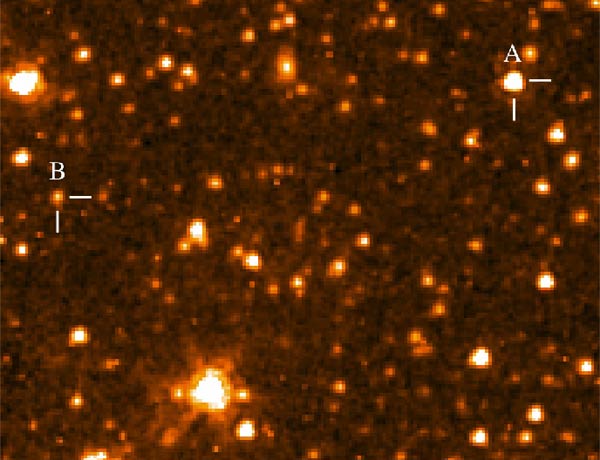







| BOOKS | F. A. Q. | ARTICLES | TALKS | ABOUT KEN | DONATE | BEYOND OUR KEN |
|---|
By Ken Croswell
Published on New Scientist (March 12, 2011)

"A" marks the white dwarf, "B" the newfound ultracool brown dwarf. Credit: Kevin Luhman.
We think of stars, even the failed ones called brown dwarfs, as being lethally hot. That picture has been confounded by a newly discovered brown dwarf--at room temperature.
Like fully fledged stars, brown dwarfs form from collapsing gas clouds, but they are not massive enough to sustain nuclear reactions. Instead, they briefly shine red from the heat of formation, then fade. Still, the coolest known brown dwarfs are all hot enough to roast any spacefarers who venture too close.
Now Kevin Luhman of Pennsylvania State University in University Park and colleagues have used NASA's infrared Spitzer Space Telescope to detect the glow of what appears to be a brown dwarf at just 80 °F (Astrophysical Journal Letters).
The object, which orbits a white dwarf star 63 light-years from Earth, weighs seven times as much as Jupiter. At that mass, it would normally be considered a planet. But planets form from disks of gas and dust around stars, and the researchers say that the object, known as WD 0806-661 B, lies too far from its star--at 2500 times the Earth's distance from the Sun--to be deemed a planet if it formed where it is.
The object is a lot hotter than Jupiter, which is at a frigid -236 °F, and much cooler than the next coolest brown dwarf, at 210 °F. This means that WD 0806-661 B will act as a "missing link" to reveal how temperature affects the atmosphere and spectral features of objects that are roughly the size of Jupiter.
Ken Croswell is an astronomer and the author of The Lives of Stars.
"A stellar picture of what we know or guess about those distant lights."--Kirkus. See all reviews of The Lives of Stars here.
| BOOKS | F. A. Q. | ARTICLES | TALKS | ABOUT KEN | DONATE | BEYOND OUR KEN |
|---|